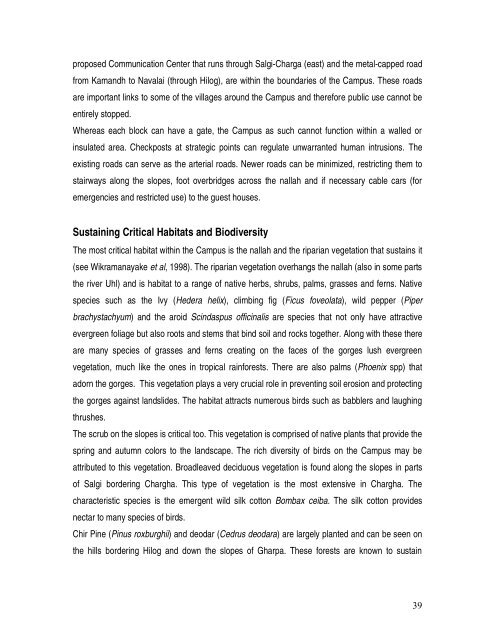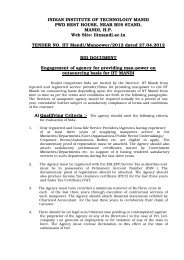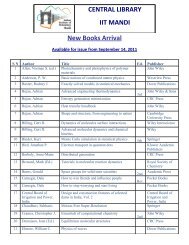Eco Report of the area - IIT Mandi
Eco Report of the area - IIT Mandi
Eco Report of the area - IIT Mandi
You also want an ePaper? Increase the reach of your titles
YUMPU automatically turns print PDFs into web optimized ePapers that Google loves.
proposed Communication Center that runs through Salgi-Charga (east) and <strong>the</strong> metal-capped road<br />
from Kamandh to Navalai (through Hilog), are within <strong>the</strong> boundaries <strong>of</strong> <strong>the</strong> Campus. These roads<br />
are important links to some <strong>of</strong> <strong>the</strong> villages around <strong>the</strong> Campus and <strong>the</strong>refore public use cannot be<br />
entirely stopped.<br />
Whereas each block can have a gate, <strong>the</strong> Campus as such cannot function within a walled or<br />
insulated <strong>area</strong>. Checkposts at strategic points can regulate unwarranted human intrusions. The<br />
existing roads can serve as <strong>the</strong> arterial roads. Newer roads can be minimized, restricting <strong>the</strong>m to<br />
stairways along <strong>the</strong> slopes, foot overbridges across <strong>the</strong> nallah and if necessary cable cars (for<br />
emergencies and restricted use) to <strong>the</strong> guest houses.<br />
Sustaining Critical Habitats and Biodiversity<br />
The most critical habitat within <strong>the</strong> Campus is <strong>the</strong> nallah and <strong>the</strong> riparian vegetation that sustains it<br />
(see Wikramanayake et al, 1998). The riparian vegetation overhangs <strong>the</strong> nallah (also in some parts<br />
<strong>the</strong> river Uhl) and is habitat to a range <strong>of</strong> native herbs, shrubs, palms, grasses and ferns. Native<br />
species such as <strong>the</strong> Ivy (Hedera helix), climbing fig (Ficus foveolata), wild pepper (Piper<br />
brachystachyum) and <strong>the</strong> aroid Scindaspus <strong>of</strong>ficinalis are species that not only have attractive<br />
evergreen foliage but also roots and stems that bind soil and rocks toge<strong>the</strong>r. Along with <strong>the</strong>se <strong>the</strong>re<br />
are many species <strong>of</strong> grasses and ferns creating on <strong>the</strong> faces <strong>of</strong> <strong>the</strong> gorges lush evergreen<br />
vegetation, much like <strong>the</strong> ones in tropical rainforests. There are also palms (Phoenix spp) that<br />
adorn <strong>the</strong> gorges. This vegetation plays a very crucial role in preventing soil erosion and protecting<br />
<strong>the</strong> gorges against landslides. The habitat attracts numerous birds such as babblers and laughing<br />
thrushes.<br />
The scrub on <strong>the</strong> slopes is critical too. This vegetation is comprised <strong>of</strong> native plants that provide <strong>the</strong><br />
spring and autumn colors to <strong>the</strong> landscape. The rich diversity <strong>of</strong> birds on <strong>the</strong> Campus may be<br />
attributed to this vegetation. Broadleaved deciduous vegetation is found along <strong>the</strong> slopes in parts<br />
<strong>of</strong> Salgi bordering Chargha. This type <strong>of</strong> vegetation is <strong>the</strong> most extensive in Chargha. The<br />
characteristic species is <strong>the</strong> emergent wild silk cotton Bombax ceiba. The silk cotton provides<br />
nectar to many species <strong>of</strong> birds.<br />
Chir Pine (Pinus roxburghii) and deodar (Cedrus deodara) are largely planted and can be seen on<br />
<strong>the</strong> hills bordering Hilog and down <strong>the</strong> slopes <strong>of</strong> Gharpa. These forests are known to sustain<br />
39
















